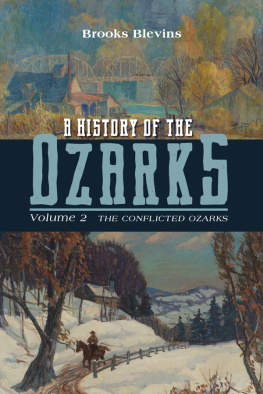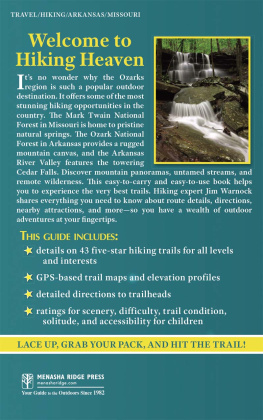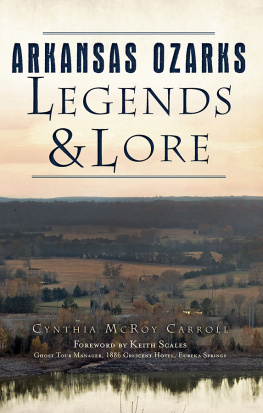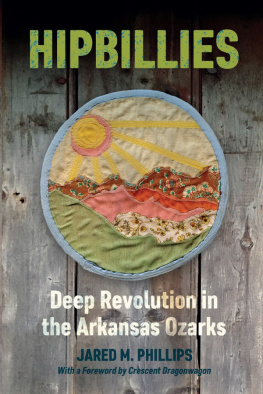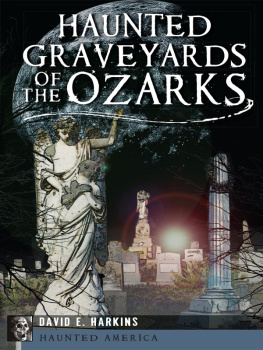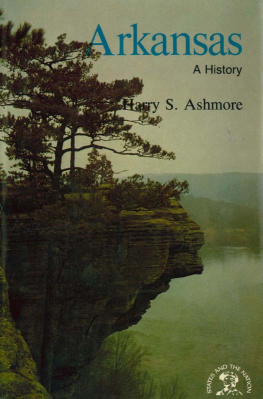Photo on page iii: Ozark hill folks, Izard County, date unknown.
Courtesy of Betty Brunson.
ILLUSTRATIONS MAPS, AND TABLE
ILLUSTRATIONS
Harvesting wheat in northwestern Arkansas
Sorghum mill, Baxter County, ca. 1930s
Ash Flat Church of Christ, Sharp County, ca. 1900
Ozark Queen on the upper White River
Williams Cooperage Company, Leslie, Arkansas
Doniphan Lumber Company employees, Cleburne County, ca. 1915
Manganese miners, Independence County, ca. 1914
Limestone mining operation, Independence County, ca. 1950s
Packing apples on the Grabill Farm, Washington County, ca. 1910
Cattle auction, Mountain Home, ca. 1930s
Farmstead and cornfield, Baxter County, ca. 1930s
View of Washington County farm, ca. 1938-41
Hillbilly postcard, Crawford County, ca. 1930s
Scattering new chicks in a modern poultry barn, Independence County, ca. 1980s
Farmers Livestock Auction Company, Springdale, 1958
Migrant worker family, Washington County, ca. 1938-41
Picking cotton in the Greenbrier bottoms, Independence County
Country store, Boone County, 1942
Vance Randolph and Otto Ernest Rayburn, ca. 1953
MAPS
1.1 Counties in the Ozarks
1.1 Geographic Regions of the Ozarks
2.1 Cotton Acreage, 1890
4.1 Railroads in the Ozarks, 1920
7.1 Poultry Sales, 1992
7.2 Cattle, 1992
8.1 Population Change, 1940-1960
8.2 Population Change, 1960-1990
9.1 Rivers and Reservoirs in the Ozarks
TABLE
7.1 Row Crop Acreage in the Ozarks, 1929, 1949, 1969
PREFACE
I BEGAN THIS WORK more than a decade ago as an undergraduate student at Arkansas (now Lyon) College, driven by a desire to better understand the history of a region that, as I was to discover, had been unsatisfactorily documented. Much has been written about the Ozarks, of course, but only a small fraction of it has been of a scholarly, historical nature. Folklorists and travel writers discovered this mid-American highland region in the early twentieth century. Perhaps this helps explain the paucity of historical treatment. Folklorist Vance Randolph, travel writer Otto Ernest Rayburn, and their successors have so dominated the image of the Ozarks that social scientists and historians have for the most part left the region to vacationers and folk song gatherers. Or perhaps the difficulty of identifying the Ozarks with some larger American region has been the stumbling block. The Ozark region, in fact, often seems a hybrid of the South, the Midwest, and the West. Maybe the historical oversight stems from the misconception that, as Randolph himself claimed, the Ozark region is simply a small edition of the Appalachian highlands.
Whatever the reasons have been, the Ozark region has largely been denied a scholarly, historical record. The ingredients for an engaging study are evident: the aforementioned disparate regional affiliations, image versus reality, and paradox. How could a region simultaneously produce a J. William Fulbright and an Orval Faubus, provide the setting for a young Bill Clintons first political race, spawn Fortune 500 companies such as Wal-Mart and Tyson Foods, and still be saddled with an image of static backwardness, of immunity from the march of time and historical progression? What follows is an attempt to take the first step in the journey to discover the story of an American region. It is my hope that this work will spark the interest of other students and potential students of Ozark history and of regional American history.
A few things about the book, its structure, and its underlying geography deserve mentioning. Geographers have long disagreed over the boundaries of the Ozark region. Fortunately for this study, most of their disagreements concern borders outside the state of Arkansas. For the purposes of this book the Ozark region comprises roughly the northwestern and north central one-quarter of the state. For statistical purposes I have limited the region to fifteen counties lying wholly within the upland region: Benton, Washington, Madison, Carroll, Boone, Newton, Van Buren, Searcy, Marion, Baxter, Stone, Cleburne, Izard, Fulton, and Sharp. In addition, the text includes references to and examples from Ozark areas in adjoining counties: Independence, Lawrence, Randolph, Johnson, Pope, and others.
The structure and style of the book may be described as narrative within the framework of chronologically organized sections. As the title suggests, Hill Folks: A History of Arkansas Ozarkers and Their Image is about a people and an image. As such it is social history, not in the sense of conforming to a certain set of methodologies, philosophies, or presuppositions but in the sense that it conveys the stories and common experiences of an identifiable group of people. Where possible I have tried to relate this story in the voices and through the experiences of the participants themselves. These Ozarkers can be as extraordinary as John Quincy Wolf Sr. and Jimmy Driftwood or as unheralded as Tom Ross and Beulah Billingsley. Finally, in an attempt to present this material as a foundation work of sorts, I have absorbed into the narrative a wide range of topics, including settlement patterns, mining, migratory labor, and travel writing. Consequently, no single topic, with the possible exception of certain agricultural activities, undergoes an exhaustive exploration. It is my sincere desire that these many threads will be pursued fully by subsequent historians and by myself in the coming years.
The aid and advice of many people have contributed invaluably to this work over the past decade. To the many Ozarkers who openly and gladly revealed to me their life stories through oral history, I offer my sincerest gratitude. Among the people who offered valuable critical readings of sections of this work at various stages are Jane B. Fagg, Charles Kimball, W. David Lewis, Joe Molnar, Conner Bailey, Guy Beckwith, Ruth Crocker, Anthony Gene Carey, W. K. McNeil, David E. Harrell, Richard Starnes, Lynn Morrow, and Robert Cochran. Jason White provided valuable assistance and advice in the making of maps for the book. The excellent staff members at the University of North Carolina Press have devoted their time and energy to make this a better book than it otherwise would have been; I especially appreciate Sian Hunter, Paula Wald, and Cornelia Wright.


